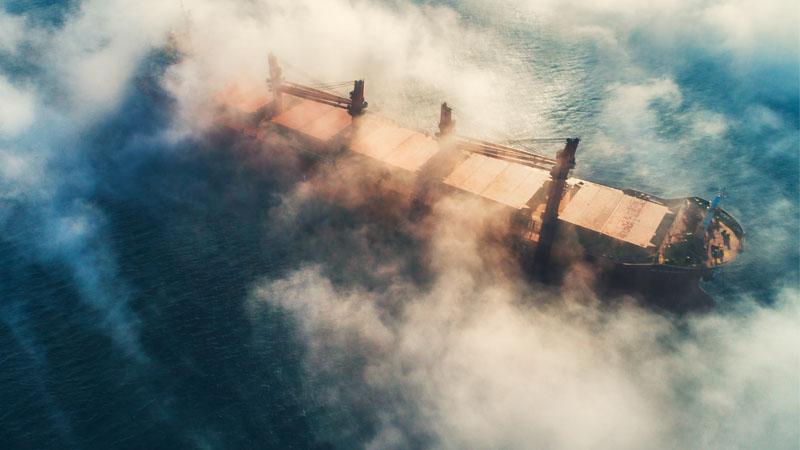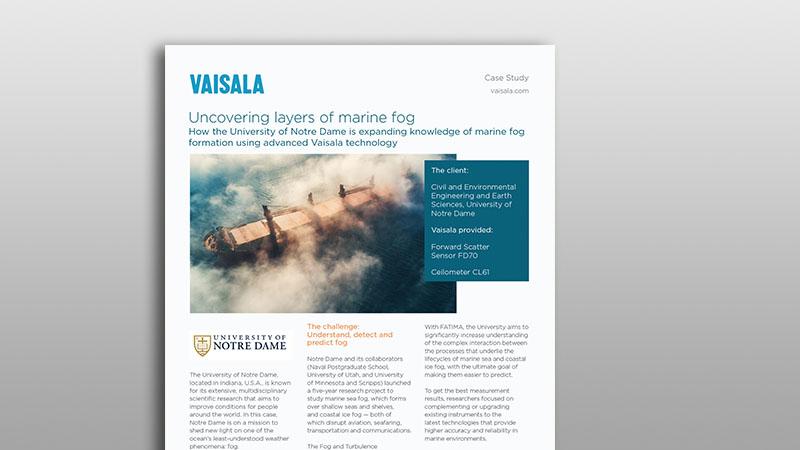Uncovering layers of marine fog
How the University of Notre Dame is expanding knowledge of marine fog formation using advanced Vaisala technology
The client: Civil and Environmental Engineering and Earth Sciences, University of Notre Dame
Vaisala provided: Forward Scatter Sensor FD70, Ceilometer CL61
The University of Notre Dame, located in Indiana, U.S.A., is known for its extensive, multidisciplinary scientific research that aims to improve conditions for people around the world. In this case, Notre Dame is on a mission to shed new light on one of the ocean’s least-understood weather phenomena: fog.
Studying fog is challenging because it involves the interaction of various processes across different scales, from nanometers to hundreds of kilometers. These processes include environmental, surface, microphysical, physicochemical, and moist thermodynamic interactions.
The challenge: Understand, detect and predict fog
Notre Dame and its collaborators (Naval Postgraduate School, University of Utah, and University of Minnesota and Scripps) launched a five-year research project to study marine sea fog, which forms over shallow seas and shelves, and coastal ice fog — both of which disrupt aviation, seafaring, transportation and communications.
The Fog and Turbulence Interactions in the Marine Atmosphere (FATIMA) project is funded by the U.S. Department of Defense’s Multidisciplinary University Research Initiative through the Office of Naval Research. More than a dozen universities and national research laboratories have also contributed to the project.
With FATIMA, the University aims to significantly increase understanding of the complex interaction between the processes that underlie the lifecycles of marine sea and coastal ice fog, with the ultimate goal of making them easier to predict.
To get the best measurement results, researchers focused on complementing or upgrading existing instruments to the latest technologies that provide higher accuracy and reliability in marine environments.
The solution: Precise measurements on sea and land
FATIMA researchers selected two Vaisala Forward Scatter Sensor FD70s and a Vaisala Lidar Ceilometer CL61 to their collection of state-of-the-art instruments. The team utilized the advanced technology to gain insights over two years of field campaigns, including two ships and one island. The instrument collection also included a micro rain radar, optical disdrometer, anemometry system and vertical microstructure (turbulence) profiler.
The FD70 measures precipitation type, size, fall speed and accumulation, weather and visibility with unprecedented accuracy, and also acts as highly accurate particle disdrometer. The FD70s provided highly accurate local atmospheric parameters, including visibility, weather type, temperature, dew point, and spectra of droplet size and droplet speed in the presence of fog and precipitation.
Researchers used the FD70s as the main instrument to measure visibility and also as a reference for other instruments nearby that measured parameters like droplet spectra and temperature at a finer scale. On the ship, it provided indicators on larger hydrometeors and helped identify the evolution of visibility during the fog life cycle. The FD70 measurements were invaluable in defining useful IOPs period, as the ship was in fog most of the time which made it hard to visually identify fog and mist.
The Ceilometer CL61 provides optical depolarization measurement that allows researchers to identify liquid versus solid precipitation, cloud phase and melting layer.
It can also characterize different aerosols, liquid droplets, drizzle and raindrops, snow and ice crystals, as well as dust, volcanic ash and sand. CL61 is also much more effective than traditional ceilometers for detecting icing and freezing conditions as well as mixing layer height, and can be used for water vapor studies.
The results: Expanding knowledge and future studies
The FATIMA team is publishing several papers to share results, and their efforts are expanding the understanding of the underlying processes of fog formation and dissipation. For example, researchers have identified the qualitative dynamical features of fog and the two variables that control its formation and dissipation.
With the conclusion of these FATIMA campaigns, the technology is being kept at the University of Notre Dame to be shared for multidisciplinary research. The full complement of measurement instruments will greatly enhance other field programs and help to advance more air-sea interaction and atmosphere/ocean boundary layer studies.
"Low visibility from fog raises numerous logistic and safety issues for aviation, seafaring and transportation. Our study focuses on fog’s formation and dissipation which will help us uncover the clues to predicting it. The FD70 and CL61 are impressive for their high accuracy, sensitivity, and ability to perform in the demanding environments we use them. They will be instrumental for conducting many more studies." Harindra Joseph S. Fernando, University of Notre Dame

